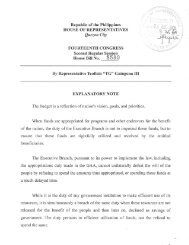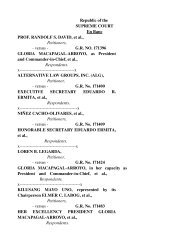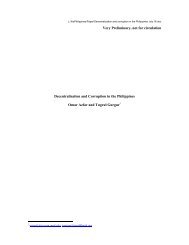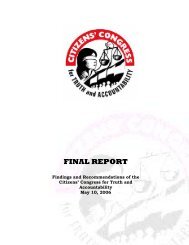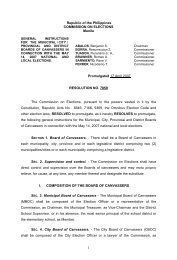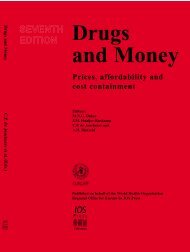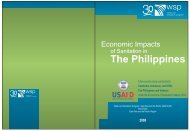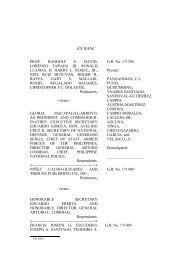The state of water resources in the Philippines - Greenpeace
The state of water resources in the Philippines - Greenpeace
The state of water resources in the Philippines - Greenpeace
You also want an ePaper? Increase the reach of your titles
YUMPU automatically turns print PDFs into web optimized ePapers that Google loves.
E. O<strong>the</strong>r threats to <strong>water</strong> availability<br />
<strong>The</strong> situation presented earlier clearly shows how various problems on <strong>water</strong> use<br />
and distribution lead to <strong>water</strong> scarcity <strong>in</strong> different areas <strong>in</strong> <strong>the</strong> country.<br />
<strong>The</strong>re are o<strong>the</strong>r factors, however, that need greater attention now as <strong>the</strong>se affect<br />
not only <strong>the</strong> supply but <strong>the</strong> availability <strong>of</strong> <strong>water</strong> <strong>resources</strong> itself. One <strong>of</strong> <strong>the</strong>se is<br />
<strong>the</strong> significant decl<strong>in</strong>e and deterioration <strong>of</strong> <strong>water</strong>sheds. Excessive logg<strong>in</strong>g and<br />
shift<strong>in</strong>g cultivation <strong>in</strong> <strong>the</strong> <strong>water</strong>sheds trigger widespread degradation and<br />
subsequent erosion and siltation <strong>of</strong> rivers, lakes, and reservoirs (Santos 1997, as<br />
cited <strong>in</strong> Jose and Cruz, 1999).<br />
Reports from several studies mention that most <strong>of</strong> <strong>the</strong> <strong>water</strong>sheds <strong>in</strong> <strong>the</strong><br />
Philipp<strong>in</strong>es are <strong>in</strong> critical condition as manifested by recent and recurr<strong>in</strong>g<br />
calamities such as flashfloods <strong>in</strong> Sou<strong>the</strong>rn Leyte and Nor<strong>the</strong>rn M<strong>in</strong>danao and an<br />
<strong>in</strong>crease <strong>in</strong> frequency <strong>of</strong> El Niño events <strong>in</strong> Luzon which reduces <strong>water</strong> levels <strong>in</strong><br />
dams. <strong>The</strong> World Bank also cites deteriorat<strong>in</strong>g <strong>water</strong>sheds as one <strong>of</strong> <strong>the</strong> reasons<br />
for <strong>the</strong> <strong>in</strong>crease <strong>in</strong> flood<strong>in</strong>g <strong>in</strong> recent years (WB, 2003).<br />
<strong>The</strong> report Crisis or Opportunity cites data that shows how extreme climate<br />
events/variability, such as floods, droughts, forest fires, and tropical cyclones<br />
have <strong>in</strong>creased <strong>in</strong> temperate and tropical Asia <strong>in</strong> <strong>the</strong> past few decades. In some<br />
regions, such as parts <strong>of</strong> Asia and Africa, <strong>the</strong> frequency and <strong>in</strong>tensity <strong>of</strong> droughts<br />
have also <strong>in</strong>creased. <strong>The</strong> El Niño phenomenon has been more frequent,<br />
persistent and <strong>in</strong>tense s<strong>in</strong>ce <strong>the</strong> mid-1970s.<br />
<strong>The</strong> report also presents data on extreme climatic events that occurred <strong>in</strong> <strong>the</strong><br />
country s<strong>in</strong>ce 1970, impell<strong>in</strong>g us to recognize that earth’s climate is <strong>in</strong>deed<br />
chang<strong>in</strong>g.<br />
• <strong>The</strong> Great Luzon Floods <strong>in</strong> 1972 is a typical example <strong>of</strong> heavy flood<strong>in</strong>g<br />
caused by heavy, persistent precipitation.<br />
• <strong>The</strong> Sou<strong>the</strong>rn M<strong>in</strong>danao Drought <strong>of</strong> 1998 was one <strong>of</strong> <strong>the</strong> most severe El<br />
Niño Sou<strong>the</strong>rn Oscillation to hit <strong>the</strong> country.<br />
• Landslides, triggered by earthquake or heavy ra<strong>in</strong>fall, were aggravated by<br />
man-made causes, i.e. forest denudation, modification <strong>of</strong> slope <strong>of</strong> <strong>the</strong><br />
terra<strong>in</strong>, and o<strong>the</strong>rs. From 1989 to 1999, landslides occurred almost every<br />
year <strong>in</strong> <strong>the</strong> Cordillera Adm<strong>in</strong>istrative Region. <strong>The</strong> highest number occurr<strong>in</strong>g<br />
dur<strong>in</strong>g <strong>the</strong> La Niña period <strong>of</strong> 1996 to 1999, which recorded annual total <strong>of</strong><br />
17 to 29 events that followed after a heavy ra<strong>in</strong>fall.<br />
• <strong>The</strong> Ormoc catastrophic flash flood <strong>in</strong> 1991 where<strong>in</strong> more than 5000 people<br />
perished was also cited<br />
• Camigu<strong>in</strong> flashflood <strong>in</strong> 2001, Sou<strong>the</strong>rn Leyte, and Surigao disaster <strong>in</strong> 2003,<br />
and <strong>the</strong> Aurora/Infanta floods which came after 20 days <strong>of</strong> moderate to<br />
heavy ra<strong>in</strong>fall were caused by four successive tropical cyclones towards <strong>the</strong><br />
end <strong>of</strong> 2004.<br />
Based on this study, it is anticipated that flood magnitude and frequency are<br />
projected to <strong>in</strong>crease, affect<strong>in</strong>g many regions as a consequence <strong>of</strong> repeated<br />
GREENPEACE | <strong>The</strong> <strong>state</strong> <strong>of</strong> <strong>water</strong> <strong>in</strong> <strong>the</strong> Philipp<strong>in</strong>es 31



